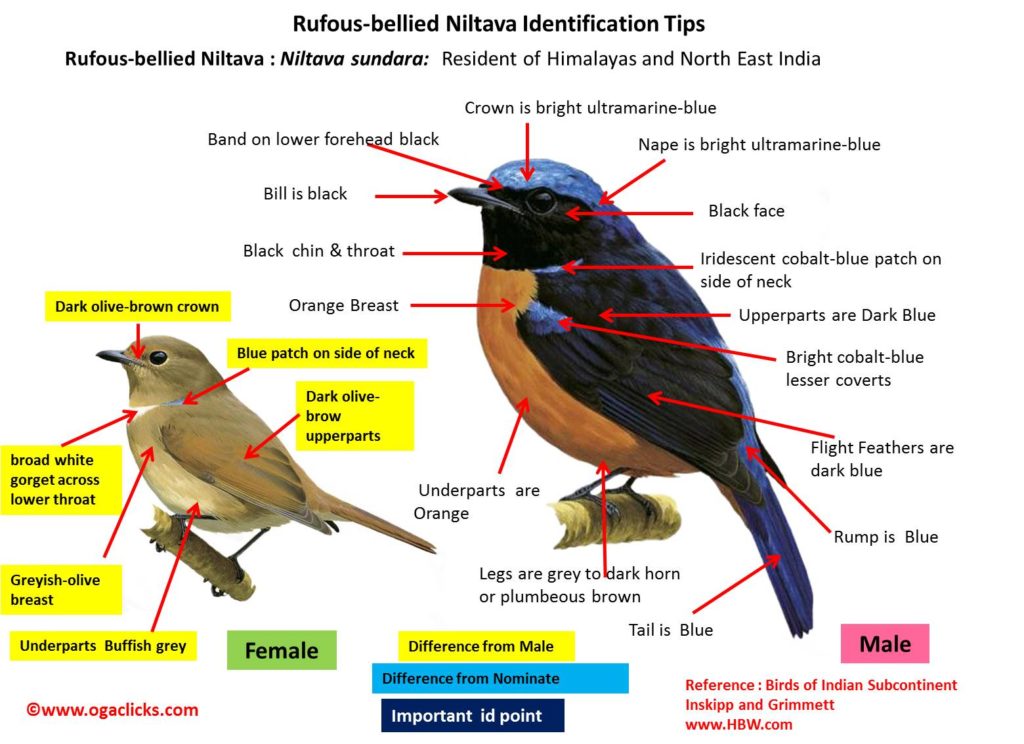
Rufous-bellied Niltava Niltava sundara
Etymology:
- Niltava : Nepalese name Niltau for the Rufous-bellied Niltava
- Sundara : Hindi word for beautiful
Vernacular Names: Lepcha: Margong, Nepal: Niltau
Distribution in India: Resident of Himalayas and North Eastern hills in India.
Description: Size of 15–18 cm; Wt. of 19–24 g. It is a large, stocky and brightly coloured flycatcher with rounded head shape, fairly short tail and broad-based bill. The male of nominate race has bright ultramarine-blue in upper forehead, crown and nape. The lower forehead, face to nape side, mantle and back are black or blackish-blue. It has an iridescent cobalt-blue patch on side of neck; rest of upperparts are deep blue, iridescent blue on rump and tail; upperwing are also deep blue, except for prominent bright cobalt-blue lesser coverts. The underparts are uniform rich orange-rufous. The iris is dark brown; bill is black; legs are grey to dark horn or plumbeous brown. The female has head and upperparts greyish olive-brown, fringes of wing-coverts and edges of flight-feathers are bright rufous, inner webs are darker or blackish, tail is broadly edged dull rufous, lores to eye and chin pale are buffish, broad white gorget across lower throat merging with small iridescent pale blue spot on side of neck, dull greyish-olive breast, buffish-grey below, whiter on centre of belly. The juvenile is similar to female but has darker brown on head and upperparts, heavily flecked on head and spotted on mantle, back and scapulars are buffish, rump and uppertail are broadly tipped buff, face finely mottled buff and brown, narrow pale buffish-yellow gorget on lower throat, breast is mostly pale buff with broad brown fringes, becoming brown bars or scaling on whitish belly and flanks; wing and tail are bluish in male, rich brown in female. The race whistleri (North India) male has paler rufous underparts than nominate, and female has paler olive-grey upperparts, paler rufous tail and more greyish-olive on underparts
Habitat: It is found in undergrowth and bushes in broadleaf evergreen and mixed conifer and deciduous forests, also locally in secondary forest and heavily degraded forest areas. It breeds from 900 m to 3200 m. In non-breeding season found from 250 m to 1350 m.
Food habits: It eats small invertebrates and larvae, ants, beetles and bush-crickets and also some fruit, such as berries. It is found solitary or in pairs also accompanies mixed-species flocks. It sits quietly or unobtrusively on low perch in undergrowth or lower levels of forest tree, occasionally darting out after passing insects or dropping to ground to catch prey. When perched, frequently adopts hunched position characteristically bobs body forwards and flicks and spreads tail when perched for long periods.
Breeding habits: They breed in Apr–Aug. The nest is built by both sexes. The nest is made of moss, fern stems, leaves and fine roots, placed low down in hole in tree stump, on ledge in rock crevice or in earth bank. They lay a clutch of 4 eggs. The incubation is done by both sexes. The incubation period is 12–13 days. The fledging period is 16–17 days. The nest is parasitized by Common Cuckoo , Oriental Cuckoo and Whistling Hawk-cuckoo.